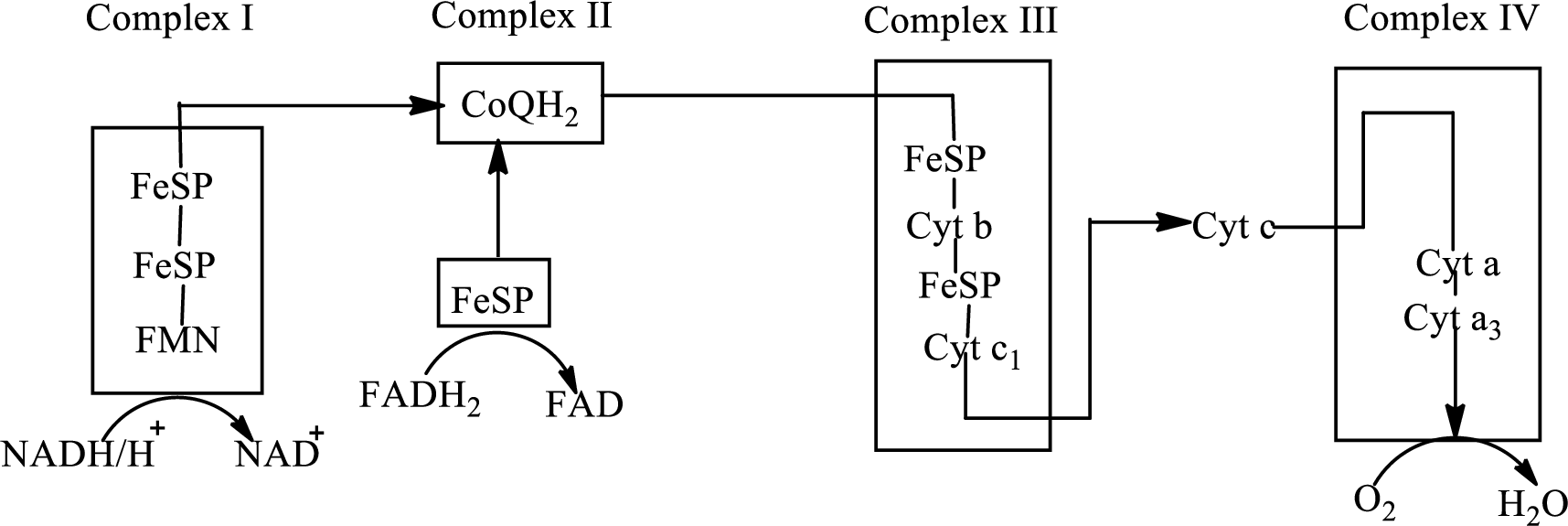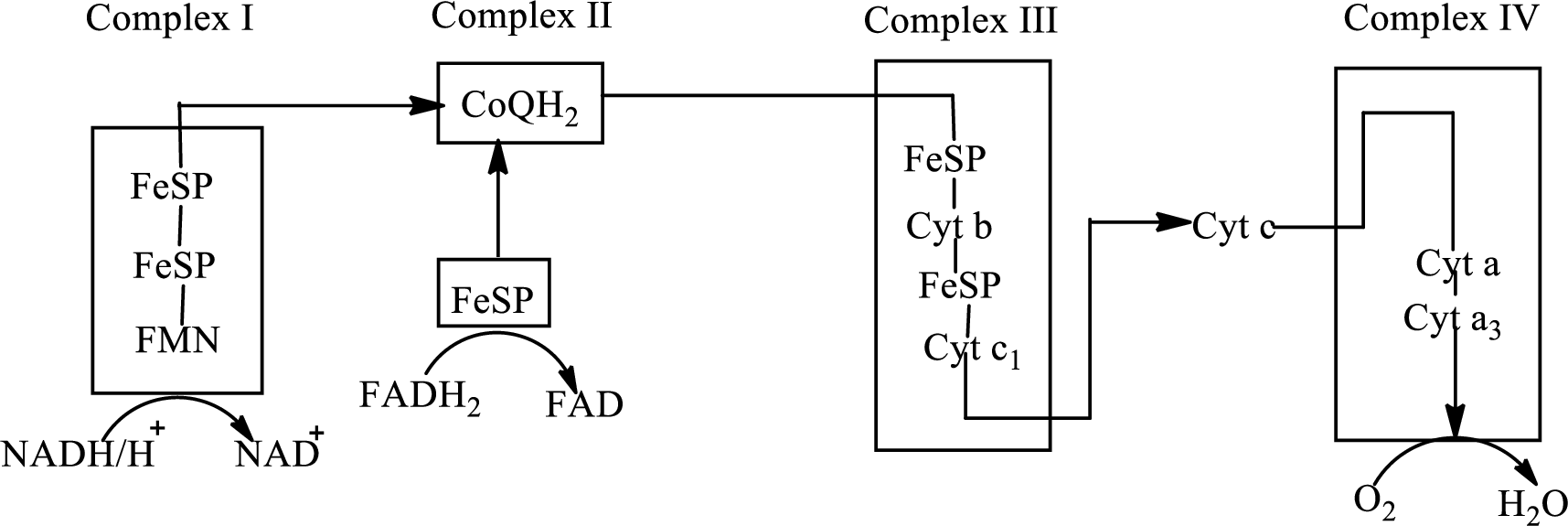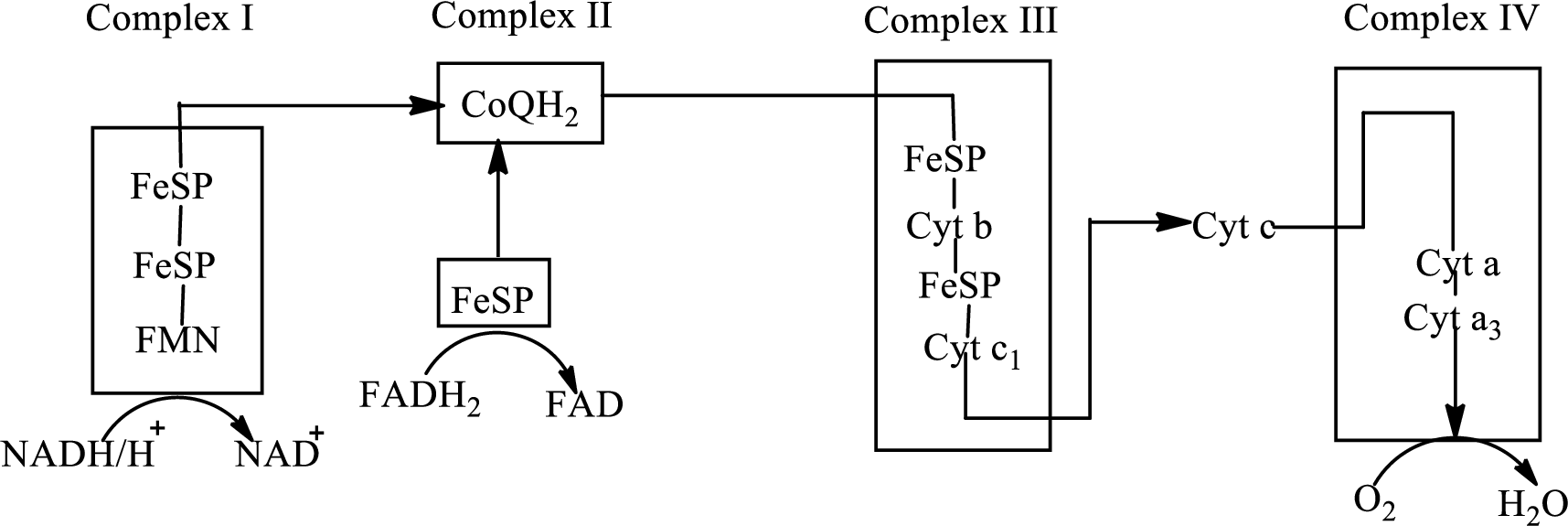
Concept explainers
(a)
Interpretation: To indicate whether
Concept introduction: Electron transport chain is a sequence of biochemical reactions in which electrons and hydrogen atoms from the citric acid cycle are transferred to various intermediate carriers and finally reacts with molecular oxygen to form a water molecule.
There are four complexes associated with the electron transport chain that is present in the inner mitochondrial membrane. The four complexes that help in the electron transfer in the electron transport chain are:
Complex I:
Complex II:
Complex III:
Complex IV:
An overview of the electron transport chain is as follows:

Redox
Here A is oxidized form and AH is reduced form.
(a)
Answer to Problem 23.87EP
Explanation of Solution
(b)
Interpretation: To indicate whether
Concept introduction: Electron transport chain is a sequence of biochemical reactions in which electrons and hydrogen atoms from the citric acid cycle are transferred to various intermediate carriers and finally reacts with molecular oxygen to form a water molecule.
There are four complexes associated with the electron transport chain that is present in the inner mitochondrial membrane. The four complexes that help in the electron transfer in the electron transport chain are:
Complex I:
Complex II:
Complex III:
Complex IV:
An overview of the electron transport chain is as follows:

Redox reactions involve oxidation and reduction reaction occurring simultaneously so that one species is oxidized and the other one is reduced. The species that gain hydrogen or electron is known as reduced form and the species that loss hydrogen or electron is known as oxidized form. The general representation of redox reaction is
Here A is oxidized form and AH is reduced form.
(b)
Answer to Problem 23.87EP
Explanation of Solution
(c)
Interpretation: To indicate whether
Concept introduction: Electron transport chain is a sequence of biochemical reactions in which electrons and hydrogen atoms from the citric acid cycle are transferred to various intermediate carriers and finally reacts with molecular oxygen to form a water molecule.
There are four complexes associated with the electron transport chain that is present in the inner mitochondrial membrane. The four complexes that help in the electron transfer in the electron transport chain are:
Complex I:
Complex II:
Complex III:
Complex IV:
An overview of the electron transport chain is as follows:

Redox reactions involve oxidation and reduction reaction occurring simultaneously so that one species is oxidized and the other one is reduced. The species that gain hydrogen or electron is known as reduced form and the species that loss hydrogen or electron is known as oxidized form. The general representation of redox reaction is
Here A is oxidized form and AH is reduced form.
(c)
Answer to Problem 23.87EP
NADH is the reduced form of the nicotinamide adenine dinucleotide.
Explanation of Solution
In complex I, electrons are transferred from the
The reaction of the oxidation of
Here,
(d)
Interpretation: To indicate whether is in its oxidized form or its reduced form.
Concept introduction: Electron transport chain is a sequence of biochemical reactions in which electrons and hydrogen atoms from the citric acid cycle are transferred to various intermediate carriers and finally reacts with molecular oxygen to form a water molecule.
There are four complexes associated with the electron transport chain that is present in the inner mitochondrial membrane. The four complexes that help in the electron transfer in the electron transport chain are:
Complex I:
Complex II:
Complex III:
Complex IV:
An overview of the electron transport chain is as follows:

Redox reactions involve oxidation and reduction reaction occurring simultaneously so that one species is oxidized and the other one is reduced. The species that gain hydrogen or electron is known as reduced form and the species that loss hydrogen or electron is known as oxidized form. The general representation of redox reaction is
Here A is oxidized form and AH is reduced form.
(d)
Answer to Problem 23.87EP
FAD is the oxidized form of the flavin adenine dinucleotide.
Explanation of Solution
In the complex II, electrons are transferred from the
Here,
Want to see more full solutions like this?
Chapter 23 Solutions
EBK GENERAL, ORGANIC, AND BIOLOGICAL CH
- If glucose labeled with 14C in C-1 is metabolized to ethanol and CO2 via fermentation, which carbon will contain 14C in: a. The CO2 b. the carbon atom carrying the OH of ethanol c. the carbonyl carbon atom of ethanol d. the methyl carbon atom of ethanolarrow_forwardWhich of the following statements about oxidation-reduction (redox) reactions is correct? A) The molecule that is oxidized loses electrons and is the oxidizing agent. B) The molecule that is reduced gains electrons and is the oxidizing agent. C) The molecule that is oxidized gains electrons and is the reducing agent.arrow_forwardAll are characteristics of catabolic reactions except a. have energy poor products b. capture energy in the form of ATP c. require coenzyme like NAD+ d. yield a greater number of products compared to anabolic reactionsarrow_forward
- Identify a metabolic pathway associated with the enzymes localized on the mitochondrial cristae. a. the citric acid cycle b. the electron transport chain c. the citric acid cycle and the electron transport chain d. none of thesearrow_forwardWhat specific reaction cannot occur due to the presence of cyanide? A.Transfer of electrons to co-enzymes B.Inability to strip a carbon from pyruvate C.Transfer of electrons to and between carrier proteins D.Addition of a phosphate onto ADP to make ATParrow_forwardIn photosynthesis, CO2 carbon atoms are transformed to glucose carbon atoms. (a) Are the CO2 carbon atoms being oxidized or reduced in this process? (b) Do the CO2 carbon atoms move to a higher or lower energy state in this process?arrow_forward
- If 30 molecules of CO2 enter the Calvin Cycle,a. How many molecules of phosphoglycerate (PGA) will be produced? b. How many molecules of glyceraldehyde phosphate (PGAL) leave the cycle? c. How many molecules of ribulose bisphosphate (RuBP) will be produced? d. How many molecules of ATP will be utilized?arrow_forwardExplain how NADH carry electrons by explaining what a hydride is. Which metabolites can potentially accumulate when complex I of the electron transport chain is defective? Do you think NAD therapy will help with hangovers? Explain.arrow_forwardIf you were to ferment grapes into wine in an organism that did not have NADH, what would likely be produced from the glucose that is consumed? a) Pyruvate b) Acetaldehydearrow_forward
- Write a balanced equation showing the conversion of glucose and oxygen to carbon dioxide and water: (a) Indicate in your equation which molecule becomes reduced? (b) Indicate in your equation which molecule becomes oxidized? (c) What happens to the energy that is released in this redox reaction? (d) Name the oxidizing agent.arrow_forwardIn general, the ratio of oxidized versus reduced NAD is best described by which ONE statement below? A. the NADH/NAD+ ratio is greater than 1 B. the NADH/NAD+ ratio is always changing so one cannot make generalized assertions about this ratio C. the NAD+/NADH ratio is greater than 1 D. the NAD+/NADH ratio is equal to 1arrow_forwardIndicate whether the statement is true for aerobic respiration, photosynthesis or both: NADH is oxidized to NAD+ at complex I a)Aerobic Respiration b)Photosynthesis c)Botharrow_forward
